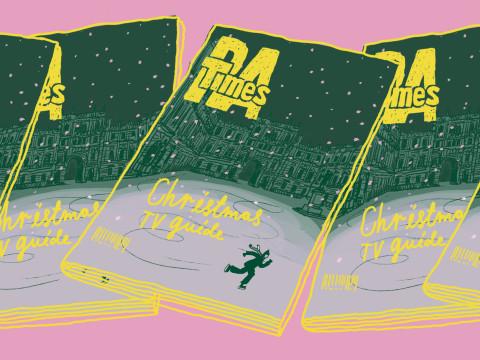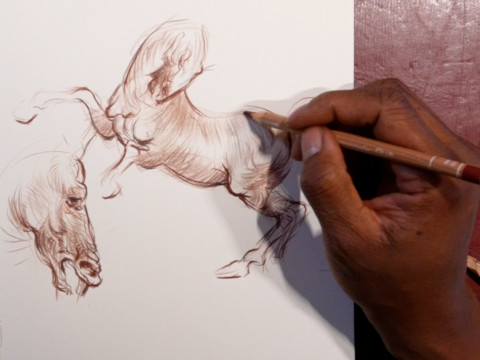
Start here: Florence c. 1504
Published on 26 September 2024
Discover the stories behind the key artworks from our latest exhibition, ‘Michelangelo, Leonardo, Raphael: Florence, c. 1504’.

Three artists in Florence
At the turn of the 16th century, three titans of the Italian Renaissance were in Florence at the same time.
Michelangelo had completed his iconic, David; Leonardo had recently returned to his native Florence and was working on a portrait of Lisa del Giocondo, better known as the Mona Lisa; and Raphael, in his early twenties and hungry for success, came to Florence to learn and to enhance his reputation.
This crossing of paths led to a period of rivalry and inspiration – the creation of masterpieces like the Bridgewater Madonna and the Burlington House Cartoon and artworks that never were such as the battle murals for the Sala del Gran Consiglio.

Michelangelo’s Taddei Tondo
Around the time he finished his David, Michelangelo began work on a round marble relief of the Virgin and Child with the Infant St John the Baptist. This ‘tondo’ (the Italian term for a round painting or relief) was commissioned by Taddeo Taddei, a young wealthy patron whose family had made their fortune in the wool trade.
The Taddei Tondo, as this work is now known, is one of the most important examples of its type.
It shows the infant St John startling the Christ Child with a goldfinch, a symbol of his Passion. The Child moves away from the bird in his mother's lap, while at the same time turning back to accept his destiny.

Raphael’s Bridgewater Madonna
Taddeo Taddei was also a patron of Raphael during the latter’s time in Florence.
It probably was while he was a guest at Taddei’s home that Raphael copied Michelangelo’s Taddei Tondo. In a few quickly sketched lines he captured the distinctive twisting pose of the Child in the Virgin’s lap. He continued to explore variations of this composition in preparatory sketches for his own Virgin and Child work, the Bridgewater Madonna.
Gone are the infant St John the Baptist and the allegorical goldfinch in this work. Instead, the Child lies across the Virgin’s lap, turning around to look up at his mother.

Leonardo’s Burlington House Cartoon
Elsewhere in Florence, Leonardo’s own work depicting the Holy Family was pulling crowds.
According to Giorgio Vasari, when Leonardo exhibited a cartoon of the Virgin and Child with the infant St John the Baptist, Florentines thronged to see the drawing “in order to gaze at the marvels of Leonardo, which caused all those people to be amazed”.
The Burlington House Cartoon (named after the Royal Academy building where it was once part of the collection) may be the very drawing described above. Made up of eight sheets of paper, the work is the only surviving large-scale drawing by Leonardo.
Its purpose has puzzled scholars for generations. It’s likely that Leonardo made it in c. 1506-08 as a proposal for an altarpiece for the Sala del Gran Consiglio – the grand council chamber in Florence’s town hall, the Palazzo Vecchio.

Leonardo’s Fight for the Standard
In 1503 that council chamber still had bare walls. The city’s government commissioned its two leading artists, Leonardo and Michelangelo, to produce two monumental murals showing Florence’s important military victories.
The commissions pitted rivals against each other – a battle of artistic one-upmanship.
Neither mural was completed, but preparatory sketches by Leonardo and Michelangelo and copies of their large-scale cartoons (made by later artists) give us an insight into both artists' plans.
Leonardo depicted the Battle of Anghiari, a Florentine victory over Milan in 1440. In the central scene of his mural, he showed four military captains in ferocious combat.
He developed his composition through a series of small sketches in pen and ink and later chalk, capturing the ferocious expressions of the soldiers and horses.

Michelangelo’s Bathers
For his commission, Michelangelo tackled the Battle of Cascina, which was fought against the Pisans in 1364. Unlike Leonardo, Michelangelo didn’t show the frenzy of the fighting, but nude soldiers, having cooled off in the River Arno, dressing hurriedly for battle.
These two profoundly different approaches offer an insight into their differing visions of what art could achieve. For Michelangelo, the body – foreshortened and in action – was the primary vehicle of expression; for Leonardo, it was the face, whether of man or beast, conveying emotion.

Book tickets for Michelangelo, Leonardo, Raphael
Starting with Michelangelo’s celebrated Taddei Tondo, this exhibition explores the rivalry between Michelangelo and Leonardo and the influence both had on the young Raphael.
Exhibition organised by the Royal Academy of Arts, London, in partnership with Royal Collection Trust and the National Gallery, London.
Related articles

Art telly to watch this Christmas
11 December 2024

Moving a masterpiece
7 November 2024

Video: learning from Leonardo at Windsor Castle
4 November 2024